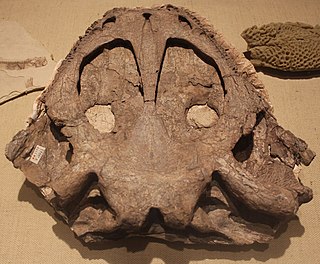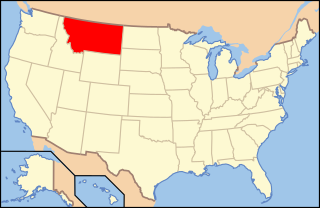
Paleontology, also spelled palaeontology or palæontology, is the scientific study of life that existed prior to, and sometimes including, the start of the Holocene Epoch. It includes the study of fossils to classify organisms and study interactions with each other and their environments. Paleontological observations have been documented as far back as the 5th century BCE. The science became established in the 18th century as a result of Georges Cuvier's work on comparative anatomy, and developed rapidly in the 19th century. The term itself originates from Greek παλαιός, palaios, "old, ancient", ὄν, on, "being, creature", and λόγος, logos, "speech, thought, study".

Trilobites are a group of extinct marine artiopodan arthropods that form the class Trilobita. Trilobites form one of the earliest-known groups of arthropods. The first appearance of trilobites in the fossil record defines the base of the Atdabanian stage of the Early Cambrian period, and they flourished throughout the lower Paleozoic before slipping into a long decline, when, during the Devonian, all trilobite orders except the Proetida died out. The last extant trilobites finally disappeared in the mass extinction at the end of the Permian about 252 million years ago. Trilobites were among the most successful of all early animals, existing in oceans for almost 300 million years.
Eshanosaurus is a genus of a dinosaur from the early Jurassic Period. It is known only from a fossil partial lower jawbone, found in China. It may be a therizinosaurian, and so the earliest known coelurosaur.

Ruehleia is a genus of sauropodomorph dinosaur from the Late Triassic period of Germany. The type species is R. bedheimensis, described by Galton in 2001, and is named for the German paleontologist Hugo Ruehle von Lilienstern. The fossils consist of one nearly complete skeleton, consisting of cervical (neck), dorsal (back), and caudal (tail) vertebrae; a partial sacrum; a scapulocoracoid; pelvic bones; most of the limb bones; and partially complete manus (hands).

Branchiosaurus is a genus of small, lightly built early prehistoric amphibians. Fossils have been discovered in strata dating from the late Pennsylvanian Epoch to the Permian Period. The taxa may be invalid; the material referred to the genus may be juvenile specimens of larger amphibians.
Paleontology or palaeontology is the study of prehistoric life forms on Earth through the examination of plant and animal fossils. This includes the study of body fossils, tracks (ichnites), burrows, cast-off parts, fossilised feces (coprolites), palynomorphs and chemical residues. Because humans have encountered fossils for millennia, paleontology has a long history both before and after becoming formalized as a science. This article records significant discoveries and events related to paleontology that occurred or were published in the year 1934.
Fresnosaurus is an extinct genus of plesiosaur from the Late Cretaceous of what is now California. The type species is Fresnosaurus drescheri, first described by Welles in 1943. The generic name Fresnosaurus honors Fresno County, while the specific name honors Arthur Drescher.

Ariekanerpeton is an extinct genus of seymouriamorph from the lower Permian. Fossils have been found from Tajikistan representing over 900 individuals of various stages of ontogenic development. However, it is thought that none of these specimens are of fully mature animals as poor bone ossification is present and the neural arches are paired and disarticulated from the pleurocentra.
Doleserpeton is an extinct, monospecific genus of dissorophoidean temnospondyl within the family Amphibamidae that lived during the Upper Permian, 285 million years ago. Doleserpeton is represented by a single species, Doleserpeton annectens, which was first described by John R. Bolt in 1969. Fossil evidence of Doleserpeton was recovered from the Dolese Brothers Limestone Quarry in Fort Sill, Oklahoma. The genus name Doleserpeton is derived from the initial discovery site in Dolese quarry of Oklahoma and the Greek root "serp-", meaning "low or close to the ground". This transitional fossil displays primitive traits of amphibians that allowed for successful adaptation from aquatic to terrestrial environments. In many phylogenies, lissamphibians appear as the sister group of Doleserpeton.

Yuanansuchus is an extinct genus of mastodonsauroid temnospondyl. Fossils have been found from the Xinlingzhen formation in Yuan'an County, Hubei, China and date back to the Anisian stage of the Middle Triassic.
Palaeopsephurus is an extinct genus of paddlefish in the Acipenseriformes family Polyodontidae. At present the genus contains the single species Palaeopsephurus wilsoni.
Chongichthys is an extinct genus of prehistoric bony fish that lived during the Oxfordian stage of the Late Jurassic epoch. Fossils of the genus have been found in the Quebrada El Profeta of Chile.
Dianosuchus is an extinct genus of protosuchid crocodylomorph. Fossils have been found from the Dark Red Beds of the Lower Lufeng Formation in Yunnan, China, dating back to the Sinemurian stage of the Early Jurassic. It is characterized by an unusually flattened snout compared to other protosuchians, conical isodont teeth that lacked striations, and very small antorbital fenestrae.
Euscolosuchus is an extinct genus of suchian closely related to crocodylomorphs. Fossils have been found from the Tomahawk Creek Member of the Turkey Branch Formation outcropping in east-central Virginia. The locality from which the material was found dates back to the early Carnian stage of the Late Triassic, based on palynological studies. These strata are known for the abundance of fossil material belonging to tetrapod vertebrates in relation to other sites of the Newark Supergroup in the Richmond Basin that generally lack such material. The site is unique among others in the supergroup and closely resembles localities in the southern hemisphere, as is suggested by the presence of numerous fossils of traversodont cynodonts found from the area. Other tetrapods present include procolophonians, chiniquodontids, and sphenodonts.

Asthenocormus is an extinct genus of prehistoric bony fish that lived from the Callovian stage of the Middle Jurassic epoch to the early Tithonian stage of the Late Jurassic epoch.

Eurycormus is an extinct genus of prehistoric bony fish that lived from the Callovian stage of the Middle Jurassic epoch to the early Tithonian stage of the Late Jurassic epoch.
Hadongsuchus is an extinct genus of "protosuchian" crocodylomorph from the Hasandong Formation of Hadong, South Korea.

Paleontology in Wisconsin refers to paleontological research occurring within or conducted by people from the U.S. state of Wisconsin. The state has fossils from the Precambrian, much of the Paleozoic, and the later part of the Cenozoic. Most of the Paleozoic rocks are marine in origin. Because of the thick blanket of Pleistocene glacial sediment that covers the rock strata in most of the state, Wisconsin’s fossil record is relatively sparse. In spite of this, certain Wisconsin paleontological occurrences provide exceptional insights concerning the history and diversity of life on Earth.

Paleontology in Montana refers to paleontological research occurring within or conducted by people from the U.S. state of Montana. The fossil record in Montana stretches all the way back to the Precambrian. During the Late Precambrian, western Montana was covered by a warm, shallow sea where local bacteria formed stromatolites and bottom-dwelling marine life left tracks on the sediment that would later fossilize. This sea remained in place during the early Paleozoic, although withdrew during the Silurian and Early Devonian, leaving a gap in the local rock record until its return. This sea was home to creatures including brachiopods, conodonts, crinoids, fish, and trilobites. During the Carboniferous the state was home to an unusual cartilaginous fish fauna. Later in the Paleozoic the sea began to withdraw, but with a brief return during the Permian.










